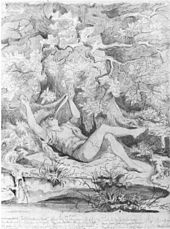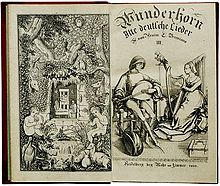The boy's magic horn

From 1805 to 1808 , Clemens Brentano and Achim von Arnim published a collection of folk song texts in three volumes under the title Des Knaben Wunderhorn . It contains 723 love , soldier , hiking and children's songs from the Middle Ages to the 18th century .
The title copper of the second volume depicts the Oldenburger Wunderhorn .
Cultural and historical background
The younger followers of Romanticism , deeply moved by national feeling, devoted themselves to the collection and study of the origins of the Germanic past in folk songs, fairy tales, myths, sagas ( Nibelungen saga ), and Germanic poetry ( Edda ). Anything that was unaffected by what they saw as the negative effects of modern civilization was considered good and helpful for the “recovery of the nation”.
Philological dispute
In the context of a general dispute between the Heidelberg Romantics and the scholar Johann Heinrich Voss who also resided there , the possibility of a "pure" illustration of folk poetry, especially in a conflict between the editors, was discussed for a long time:
Brentano criticized Arnim that his restoration of the found works were too "poetic" and went far beyond mere restorations. The Brothers Grimm also intervened in the ensuing debate about natural poetry and art poetry , with Jacob Grimm advocating a “naive”, “true” and “necessary” poetry, whereas his brother Wilhelm Grimm definitely wanted translatability and editability - for example from foreign languages Myths - affirmed.
Goethe , to whom the first volume of the series was dedicated, also published - as a thank you - a review and praised both the naive claim of the series and its suitability for scholars. He recommended Des Knaben Wunderhorn for every kitchen “of the common people” and for every piano of the “learned”.
The claim to a collection of old German songs from the people remains controversial to this day, the accusation of falsification and self-creation - especially against Arnim - sometimes seems excessive, but the different definitions of art of the editors and possible claims to the work should be clearly separated and differentiated.
The modern critical edition
The authoritative edition of Des Knaben Wunderhorn appeared in four volumes from 1975 to 1978 (the fourth volume being divided into three volumes) as part of the historical-critical Frankfurt Brentano edition (edited by Heinz Rölleke ). This Wunderhorn edition is based on decades of research and the legacy of East Berlin folklorist Harry Schewe (1885–1963).
Idioms
The first volume also contains the song Frau Nachtigal , which probably provided the basis for the Berlin phrase " Nachtigall , ick hear 'dir traps". The Berliner expresses that he noticed something in advance or “smelled the roast”.
Remarks
In 1860 Theodor Colshorn published Des Deutschen Knaben Wunderhorn. Graduated selection of German poems for boys and youngsters. From the sources. , from the second edition onwards only Des Knaben Wunderhorn is shortened . [...] .
expenditure
- Achim von Arnim, Clemens Brentano (ed.): Des Knaben Wunderhorn. Old German songs . 3 volumes. Heidelberg: Mohr and Zimmer, 1806/1808. First edition (vol. 1, digitized and full text in the German text archive ; vol. 2., digitized and full text in the German text archive ; vol. 3. digitalized and full text in the German text archive ; 1st volume in the Google book search, 2nd volume in the Google Book Search).
- Achim von Arnim, Clemens Brentano (ed.): Des Knaben Wunderhorn. Old German songs . 3 volumes. Heidelberg: Mohr and Zimmer, 2 1819 (reprint: JCB Mohr, Tübingen 1926).
- Achim von Arnim, Clemens Brentano (ed.): Des Knaben Wunderhorn. Old German songs ; ed. by Heinz Rölleke. Critical edition (= Frankfurt Brentano edition . Volumes 6–8 and 9.1–9.3). Kohlhammer, Stuttgart 1975–78, ISBN 3-17-002105-2 / ISBN 3-17-002106-0 / ISBN 3-17-002723-9 / ISBN 3-17-002282-2 / ISBN 3-17-002283- 0 / ISBN 3-17-002284-9 .
- Achim von Arnim, Clemens Brentano (ed.): Des Knaben Wunderhorn. Old German songs ; ed. by Heinz Rölleke. Insel, Frankfurt am Main / Leipzig 2003, ISBN 3-458-17150-9 .
- Achim von Arnim, Clemens Brentano (ed.): Des Knaben Wunderhorn. Old German songs ; ed. by Heinz Rölleke. 3 volumes. Reclam, Stuttgart 2006, ISBN 3-15-030034-7 .
literature
- Antje Tumat, Caren Benischek (ed.): From Volkston and Romanticism: Des Knaben Wunderhorn in der Musik. Winter, Heidelberg 2008, ISBN 978-3-8253-5333-9 .
- Urs Büttner: Poiesis of the “social”. Achim von Arnim's early poetics up to the Heidelberg Romanticism (1800–1808). de Gruyter, Berlin / Boston 2015, ISBN 978-3-11-031457-1 (also dissertation University of Tübingen 2012).
- Misako Hori: Das Wunderhorn: on the conceptual meaning of the title copper for Achim von Arnim's and Clemens Brentano's collection of songs, Des Knaben Wunderhorn. Lang, Frankfurt am Main etc. 2007, ISBN 978-3-631-57390-7 (also dissertation University Bamberg 2003).
- Walter Pape (Ed.): The “Wunderhorn” and Heidelberg Romanticism: Orality, Written Form, Performance . Heidelberg Colloquium of the International Arnim Society. Niemeyer, Tübingen 2005, ISBN 3-484-10866-5 .
- Otto Holzapfel : List of songs. The older German-language popular song tradition . Online version (as of November 2018) on the homepage of the Volksmusikarchiv des Bezirks Oberbayern (in PDF format; further updates planned), own file Des Knaben Wunderhorn, Heidelberg 1806-1806 .
Web links
- Achim von Arnim, Clemens Brentano: Des Knaben Wunderhorn. 1st volume in the Gutenberg-DE project (text based on the Stuttgart edition: Reclam, 1987)
- Achim von Arnim, Clemens Brentano: Des Knaben Wunderhorn. 2nd volume in the Gutenberg-DE project (text based on the Stuttgart edition: Reclam, 1987)
- Achim von Arnim, Clemens Brentano: Des Knaben Wunderhorn. Volume 3 in the Gutenberg-DE project (text based on the Stuttgart edition: Reclam, 1987)
- Des Knaben Wunderhorn at Zeno.org .
- The nurse watch. Text and illustrations from "Des Knaben Wunderhorn", Appendix: Children's songs
Individual evidence
- ↑ Armin Schlechter: Des Knaben Wunderhorn: A snapshot of the popular song
- ^ René Wellek : History of literary criticism. 1750-1950. Volume 1: The late 18th century, the age of romanticism (= comparative studies 7). de Gruyter, Berlin et al. 1978, ISBN 3-11-005914-2 , p. 526.
- ^ Ms. Nachtigal in the Gutenberg-DE project


